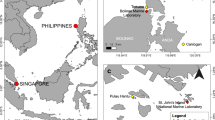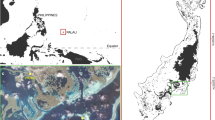Abstract
The reproductive ecology of the zooxanthellate reef coral Pavona clavus was investigated at several sites in Costa Rica, Panamá, and the Galápagos Islands (Ecuador) over the period 1985–2009. Pavona clavus displayed stable gonochorism as only five hermaphrodites were found in 590 samples. At four of five locations, sex ratios were skewed toward female dominance; however, at Saboga Island (Panamá) male colonies predominated. In Panamá, sexual maturity was observed in an estimated eight-year-old female colony, and several colonies of 10–20 years of age demonstrated gametogenesis. Sexual activity was observed at all study sites, but gamete development occurred in only 14–31% of colonies sampled sporadically. Seasonality of gametogenic activity occurred predominantly during the warm/wet season, June to August, at mainland sites (Caño Island, Costa Rica, and Gulfs of Chiriquí and Panamá, Panamá). This pattern was repeated in the Galápagos Islands, but mainly from March to May when seasonally high sea temperatures and rainfall prevailed there. Histological sampling and field observations indicated that spawning was centered around the full moon, most frequently on lunar day 17, and near sunset (1,800 h). Mean fecundity (mature ova cm−2 live tissue) estimates were significantly different for two sites and ranged from ~1,780 (Saboga Island, Gulf of Panamá, seasonally upwelling) to ~4,280 (Uva Is, Gulf of Chiriquí, non-upwelling). Assuming three annual spawning events colony−1 (August, September, October), extrapolation of minimum and maximum fecundities yield 5,340 and 12,840 ova cm−2 year−1. Seasonal, lunar, and diel spawning patterns in nine zooxanthellate species at Uva Island indicate asynchronous coral community spawning.









Similar content being viewed by others
References
Babcock RC (1984) Reproduction and distribution of two species of Goniastrea (Scleractinia) from the Great Barrier Reef Province. Coral Reefs 2:187–195
Babcock RC, Bull GD, Harrison PL, Heyward AJ, Oliver JK, Wallace CC, Willis BL (1986) Synchronous spawnings of 105 scleractinian coral species on the Great Barrier Reef. Mar Biol 90:379–394
Baker AC, Glynn PW, Riegl B (2008) Climate change and coral reef bleaching: an ecological assessment of long-term impacts, recovery trends and future outlook. Estuar Coast Shelf Sci 80:435–471
Colgan MW (1991) El Niño and coral reef development in the Galápagos Islands: a study of the Urvina Bay uplift. In: James MJ (ed) Galápagos marine invertebrates: taxonomy, biogeography and evolution in Darwin’s Islands. Plenum Press, New York, pp 99–120
Colley SB, Glynn PW, May AS, Maté JL (2006) Species-dependent reproductive responses of eastern Pacific corals to the 1997–1998 ENSO event. Proc 10th Int Coral Reef Symp. Okinawa 1:61–70
Connell JH (1997) Disturbance and recovery of coral assemblages. Coral Reefs 16(Suppl):S101–S113
Cortés J, Guzmán HM (1998) Organismos de los arrecifes coralinos de Costa Rica: descripción, distribución geográfica e historia natural de los corales zooxantelados (Anthozoa: Scleractinia) del Pacífico. Rev Biol Trop 46:55–92
Cortés J, Jiménez C (2003) Corals and coral reefs of the Pacific of Costa Rica: history, research and status. In: Cortés J (ed) Latin American coral reefs. Elsevier, Amsterdam, pp 361–385
D’Croz LD, O’Dea A (2007) Variability in upwelling along the Pacific shelf of Panama and implications for the distribution of nutrients and chlorophyll. Est Coast Shelf Sci 73:325–340
Dana JD (1846–1849) Report on the zoophytes. U S Exploring Exped 7, 740 [1846] atlas, 61 pls [1849]
Dunbar RB, Wellington GM, Colgan MW, Glynn PW (1994) Eastern Pacific sea surface temperature since 1600 A.D.: the δ18O record of climate variability in Galápagos corals. Paleoceanography 9:291–315
Glynn PW (1990) Coral mortality and disturbances to coral reefs in the tropical eastern Pacific. In: Glynn PW (ed) Global ecological consequences of the 1982-1983 El Niño Southern Oscillation. Elsevier Oceanogr Ser 52, Elsevier, Amsterdam, pp 55–126
Glynn PW (1999) Pocillopora inflata, a new species of scleractinian coral (Cnidaria: Anthozoa) from the tropical eastern Pacific. Pac Sci 53:168–180
Glynn PW (2008) Food-web structure and dynamics of eastern tropical Pacific coral reefs: Panamá and Galápagos Islands. In: McClanahan TR, Branch GM (eds) Food webs and the dynamics of marine reefs. Oxford University Press, Oxford, pp 185–208
Glynn PW, Ault JS (2000) A biogeographic analysis and review of the far eastern Pacific coral reef region. Coral Reefs 19:1–23
Glynn PW, Colley SB (2008) Survival of brooding and broadcasting reef corals following large scale disturbances: is there any hope for broadcasting species during global warming? In: Proceedings of 11th international coral reef symposium, Ft. Lauderdale (session 11), pp 1–5
Glynn PW, Fong P (2006) Patterns of reef coral recovery by the regrowth of surviving tissues following the 1997-98 El Niño warming and 2000, 2001 upwelling cool events in Panamá, eastern Pacific. In: Proceedings of 10th international coral reef symposium, Okinawa, vol 1, pp 624–630
Glynn PW, Stewart RH, McCosker JE (1972) Pacific coral reefs of Panamá: structure, distribution and predators. Geol Rundschau 61:483–519
Glynn PW, Gassman NJ, Eakin CM, Cortés J, Smith DB, Guzmán HM (1991) Reef coral reproduction in the eastern Pacific: Costa Rica, Panamá, and Galápagos Islands (Ecuador). I. Pocilloporidae. Mar Biol 109:355–368
Glynn PW, Colley SB, Eakin CM, Smith DB, Cortés J, Gassman NJ, Guzmán HM, Del Rosario JB, Feingold JS (1994) Reef coral reproduction in the eastern Pacific: Costa Rica, Panamá, and Galápagos Islands (Ecuador). II. Poritidae. Mar Biol 118:191–208
Glynn PW, Colley SB, Gassman NJ, Black K, Cortés J, Maté JL (1996) Reef coral reproduction in the eastern Pacific: Costa Rica, Panamá and Galápagos Islands (Ecuador). III. Agariciidae (Pavona gigantea and Gardineroseris planulata). Mar Biol 125:579–601
Glynn PW, Colley SB, Ting JH, Maté JL, Guzmán HM (2000) Reef coral reproduction in the eastern Pacific: Costa Rica, Panamá and Galápagos Islands (Ecuador). IV. Agariciidae, recruitment and recovery of Pavona varians and Pavona sp. a. Mar Biol 136:785–805
Glynn PW, Maté JL, Stemann T (2001) Pavona chiriquiensis, a new species of zooxanthellate scleractinian coral (Cnidaria: Anthozoa: Agariciidae) from the eastern tropical Pacific. Bull Biol Soc Wash 10:210–225
Glynn PW, Wellington GM, Wieters EA, Navarrete SA (2003) Reef-building coral communities of Easter Island (Rapa Nui), Chile. In: Cortés J (ed) Latin American coral reefs. Elsevier, Amsterdam, pp 473–494
Guest JR, Baird AH, Goh BPL, Chou LM (2005) Reproductive seasonality in an equatorial assemblage of scleractinian corals. Coral Reefs 24:112–116
Guzmán HM, Cortés J (1989) Coral reef community structure at Caño Island, Pacific Costa Rica. PSZNI: Mar Ecol 10:23–41
Guzmán HM, Cortés J (2001) Changes in reef community structure after fifteen years of natural disturbances in the eastern Pacific (Costa Rica). Bull Mar Sci 69:133–149
Guzmán HM, Cortés J (2007) Reef recovery 20 years after the 1982–1983 El Niño massive mortality. Mar Biol 151:401–411
Harrison PL (2011) Sexual reproduction of scleractinian corals. In: Dubinsky Z, Stambler N (eds) Coral reefs: an ecosystem in transition. Springer, Berlin, pp 59–85
Harrison PL, Hakeem A (2007) Asynchronous and pulsed multispecific reef coral spawning patterns on equatorial reefs in the Maldives Archipelago. Aust Coral Reef Soc Natl Conf, Perth
Harrison PL, Wallace CC (1990) Reproduction, dispersal and recruitment of scleractinian corals. In: Dubinsky Z (ed) Coral reefs, ecosystems of the world 25. Elsevier, Amsterdam, pp 133–207
Highsmith RC (1982) Reproduction by fragmentation in corals. Mar Ecol Prog Ser 7:207–226
Hoegh-Guldberg O, Mumby PJ, Hooten AJ, Steneck RS, Greenfield P, Gomez E, Harvell CD, Sale PF, Edwards AJ, Caldeira K, Knowlton N, Eakin CM, Iglesias-Prieto R, Muthiga N, Bradbury RH, Dubi A, Hatziolos ME (2007) Coral reefs under rapid climate change and ocean acidification. Science 318:1737–1742
Kerr AM, Baird AH, Hughes TP (2010) Correlated evolution of sex and reproductive mode in corals (Anthozoa: Scleractinia). Proc R Soc B doi:10.1098/rspb.2010.1196
Mangubhai S, Harrison PL (2008) Asynchronous coral spawning patterns on equatorial reefs in Kenya. Mar Ecol Prog Ser 360:85–96
Manzello DP (2010) Coral growth with thermal stress and ocean acidification: lessons from the eastern tropical Pacific. Coral Reefs 29:749–758
McClanahan TR (2008) Response of the coral reef benthos and herbivory to fishery closure management and the 1998 ENSO disturbance. Oecologia 155:169–177
Oliver JK, Babcock RC, Harrison PL, Willis BL (1988) Geographic extent of mass coral spawning: clues to ultimate causal factors. In: Proceedings of the 6th international coral reef symposium, Townsville, vol 2, pp 803–810
Pandolfi JM, Bradbury RH, Sala E, Hughes TP, Bjorndal KA, Cooke RG, McArdle D, McClenachan L, Newman MJH, Paredes G, Warner RR, Jackson JBC (2003) Global trajectories of the long-term decline of coral reef ecosystems. Science 301:955–958
Pearson RG (1981) Recovery and recolonization of coral reefs. Mar Ecol Prog Ser 4:105–122
Penland L, Kloulechad J, Idip D, van Woesik R (2004) Coral spawning in the western Pacific Ocean is related to solar insolation: evidence of multiple spawning events in Palau. Coral Reefs 23:133–140
Podestá GP, Glynn PW (1997) Sea surface temperature variability in Panamá and Galápagos: extreme temperatures causing coral bleaching. J Geophys Res 102(C7):15749–15759
Podestá GP, Glynn PW (2001) The 1997–98 El Niño event in Panamá and Galápagos: an update of thermal stress indices relative to coral bleaching. Bull Mar Sci 69:43–59
Quinn WH, Zopf DO, Short KS, Kuo Yang RTW (1978) Historical trends and statistics of the Southern Oscillation El Niño, and Indonesian droughts. Fish Bull 76:663–678
Robinson G (1985) The influence of the 1982-1983 El Niño on Galápagos marine life. In: Robinson G, del Pino EM (eds) El Niño in the Galápagos Islands: the 1982-1983 event. Pub Charles Darwin Found Galápagos Islands, Quito, Ecuador, pp 153–190
Seutin G, White BN, Boag PT (1991) Preservation of avian blood and tissue samples for DNA analyses. Can J Zool 69:82–90
Simpson CJ (1985) Mass spawning of scleractinian corals in the Dampier archipelago and the implications for management of coral reefs in Western Australia. West Aust Dept Conserv Environ Bull 244:35
Squires DF (1959) Results of the Puritan-American Museum of Natural History Expedition to western Mexico, 7. Corals and coral reefs in the Gulf of California. Bull Am Mus Nat Hist 118:367–432
Veron JEN (2000) Corals of the world, vol 2. Australian Institute of Marine Science, Townsville
Veron JEN, Pichon M (1979) Scleractinia of eastern Australia. Part III: families Agariciidae, Siderastreidae, Fungiidae, Oculinidae, Merulinidae, Mussidae, Pectiniidae, Caryophylliidae, Dendrophylliidae. Austral Inst Mar Sci Monogr Ser (4):459
Wellington GM (1982) An experimental analysis of the effects of light and zooplankton in coral zonation. Oecologia 52:311–320
Wellington GM, Glynn PW (2007) Responses of coral reefs to El Niño-Southern Oscillation sea warming events. In: Aronson RB (ed) Geological approaches to coral reef ecology. Ecol Stud 192:342–385
Wells JW (1983) Annotated list of the scleractinian corals of the Galápagos. In: Glynn PW, Wellington GM (eds) Corals and coral reefs of the Galápagos Islands. University of California Press, Berkeley, pp 212–291
Wilkinson CR (2004) Status of coral reefs of the world: 2004. Aust Inst Mar Sci, Cape Ferguson
Acknowledgments
For help with collections, field observations, and laboratory work, we thank Andrew Baker, Kathy Black, Celina Bourbonierre, Viktor Brandtneris, Luis D’Croz, Peggy Fong, Erin Kapostasy, Priscilla Martínez, Fernando Rivera, Tyler Smith, Lauren Toth, Aníbal Velarde, and Nancy Voss. Bernadette Bezy shared observations on spawning in Costa Rica, and for this we are very grateful. Research support was provided by the US National Science Foundation, Biological Oceanography Program, grant OCE-0526361 and earlier awards. Thanks are due to the following host-country institutions for facilitating this research: Costa Rica, Centro de Investigaciones en Ciencias del Mar y Limnología (CIMAR), Universidad de Costa Rica, and Sistema Nacional de Áreas de Conservación, Ministerio del Ambiente y Energía; Panamá, Departamento de Biología Acuática, Autoridad Nacional del Ambiente (ANAM), and Smithsonian Tropical Research Institute; Ecuador, Charles Darwin Research Station, and the Galápagos National Park Service. This is a contribution from the University of Miami, Rosenstiel School of Marine and Atmospheric Science.
Author information
Authors and Affiliations
Corresponding author
Additional information
Communicated by R. H. Richmond.
Rights and permissions
About this article
Cite this article
Glynn, P.W., Colley, S.B., Guzman, H.M. et al. Reef coral reproduction in the eastern Pacific: Costa Rica, Panamá, and the Galápagos Islands (Ecuador). VI. Agariciidae, Pavona clavus . Mar Biol 158, 1601–1617 (2011). https://doi.org/10.1007/s00227-011-1673-z
Received:
Accepted:
Published:
Issue Date:
DOI: https://doi.org/10.1007/s00227-011-1673-z




